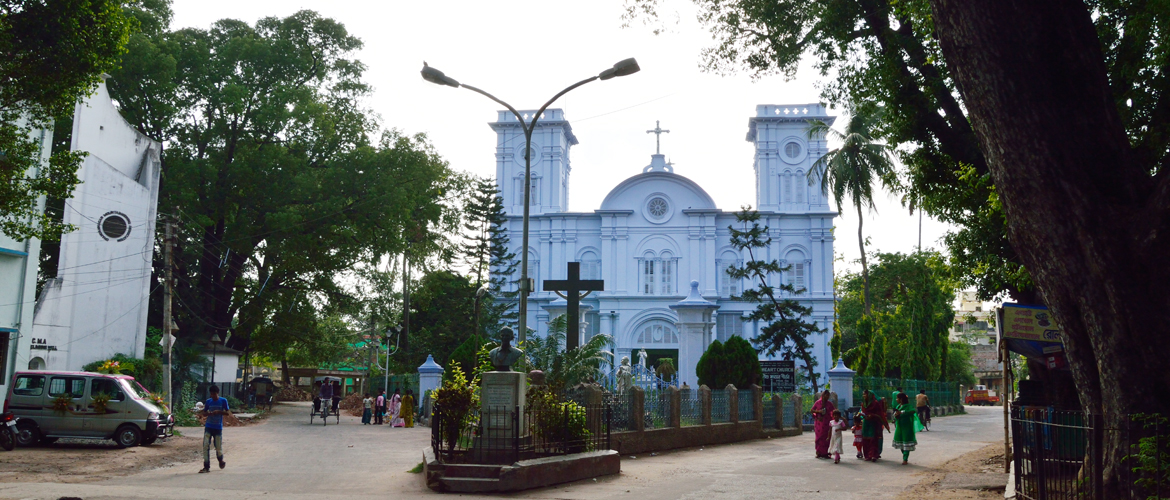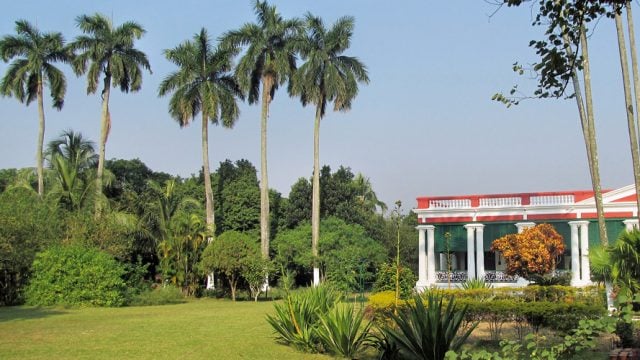The road whips like a snake backwards and forwards, narrow, and crowded with trucks. We are following

Bandel (49 km N of Kolkata)
Take the Second Howrah Bridge out towards Kalyani and the road is piled with concrete renovations. Sher Shah Sur marched down this road, elephants and all, in the 17th century, laying down a path of conquest from Delhi. Once off it, the snake takes over, so narrow that our car knocks a motorbike into a ditch during an overtaking attempt. Flurries of apologies and a question, “Where is Bandel?” Straight till the crossing, then a left.
Many lefts and questions later, it materialises suddenly, a child’s brown pastel scrawl beyond yellow gates. Bandel Basilica, built in 1599-62, years after the Portuguese first colonised Hooghly — shiny brown-and-white granite and white stars on shiny, speckled stone. Bandel Church was destroyed by the Mughals and rebuilt in the17th century. It was beatified into its present state in 1988 — stained glass; many, many flickering candles; and no signs of age or history, though there is faith in plenty.
The Victorian Imambara built in 1863 byHaji Mohammed Mohsin wears its age with grace. A thousand arches surround the old courtyard, like empty eyes looking down. Steps lead up to the prayer hall. The inside is lined with marble and inscriptions from the Quran. The caretaker directs us to the neglected garden by the river, looking up we see the Haji’s will engraved in English and Urdu high on the walls behind the Imambara, in a decorative frieze.
Shoes off again at the Russian domes of the Hanseshwari Temple, an architectural melange of Kremlin plus terracotta. This is a diversion and not relevant to the Europeans, who pitched their imperial tents by the river. We determinedly drive to Chinsurah to see whether the Ollondaz, the Hollanders, left more definite footprints than the Portuguese did.

Chinsurah (45 km N of Kolkata)
All of Chinsurah goes round and round the Gharir Mor, a clock tower and a bust that we, chasing Dutch churches and cemeteries, are far too busy to investigate. Chinsurah houses the second oldest church in Bengal,the Armenian Church. Any questions on a “Dutch Church?” redirect us back to the Armenian one. Finding the Dutch cemetery is still more difficult — we go round and round Gharir Mor until we run it to ground, blackened pyramids in a locked garden. The ash-grey stone on two of the oldest graves has somehow managed to evade the heat and humidity of Bengal. A Dutch sea captain who was born in 1698 died in 1766 and another Charles Maurits Someone slightly later in 1789. And a 19th century grave extols the virtues of a lady who was plain of speech and compliant of nature.
There is a Dutch fort, Fort Gustavson, somewhere in Chinsurah, built in 1628, but no one at the Clock Tower Crossing has heard of it, or even of the octagonal Dutch Church. They direct us instead to the Court, which is the longest building in Bengal, a yellow-washed two-storey strip built by the English. In 1825, the Dutch swapped Chinsurah for the island of Sumatra and all its spices and happily packed up their tent and left, having taken the time to invent the punkah somewhere in those few centuries.

Chandernagore (39 km N of Kolkata)
Also spelt Chandannagar, the Sandalwood Town is where the French triumphantly landed in 1673. Dupleix, Clive’s old rival, left his high 4-poster bed there in what is today the French Institute. On a Sunday afternoon, students are sitting with their professor, repeating, “un oeille, des yeux,” as he teaches them French in Bengali. Chandernagore is very français down the Strand, a beautiful riverfront street lined with colonial buildings. Dupleix disembarking here in velvet knee breeches is a fantasy that is easy on the imagination, especially since the ghat gates carry the motto “Libertie, Egalitie, Fraternitie”. The Church, just off the Strand, is graceful and European.
Serampore (32 km N of Kolkata)
Serampore (also called Shrirampur), back towards Kolkata, was once called Fredric nagar after King Fredric VI of Denmark. A garden that blooms cannons in front of the square, the no-nonsense Danish Church commemorates that piece of history. The Danes started a colony in 1616, but the East India Company took it over. Serampore became the centre for English missionaries. The first botanical garden was set up here and the Baptist leader William Carey set up the first printing press in Bengal here in 1800. It serviced the entire South and South-East Asian print market as well as those outside Europe in the 19th century. Carey’s footprints are far easier to find here than King Frederic’s. At Carey Museum, you can see his writing desk and his polyglot dictionary, among other things. In the early dusk of a Bengal winter, locating the Danish Cemetery just becomes too much effort. We admire the mist draping the river, then bump all the way back to Kolkata. Somehow the road seems to have become narrower and bumpier —a little, I think, like the Danes sulkily abandoning the pleasures of camping by the Hooghly.
Car is the best way to see most of the places. And preferably carry your own food. If you are going by train to Chinsurah, it takes about 50 minutes to reach it from Howrah by train. You can either take the Bandel Local or the Burdwan Local (Main). On no account take the Burdwan Local (Chord). There are trains to Serampore from Kolkata. Ferry services are available too. Chandernagore is easily accessible by road from Dumdum Airport. Local trains from Howrah on the Eastern Rail Main Line also run very frequently (peak frequency: one train every few minutes).
Bandel
Bandel Basilica
Chandernagore



